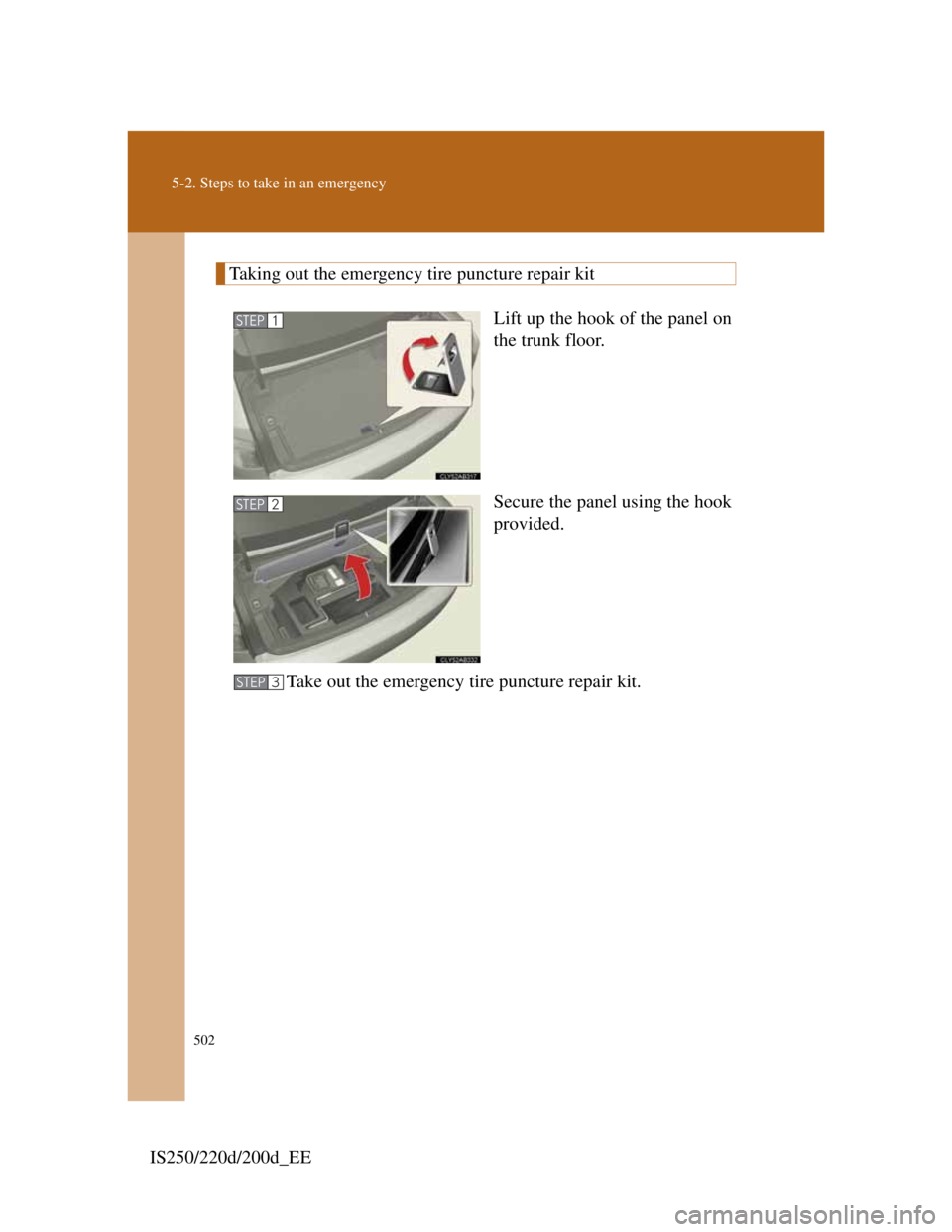5
513
5-2. Steps to take in an emergency
When trouble arises
IS250/220d/200d_EE
CAUTION
When fixing the flat tire
Stop your vehicle in a safe and flat area.
Connect the valve and hose securely with the tire installed on the vehicle.
If the hose is not properly connected to the valve, air leakage may occur or
sealant may be sprayed out.
If the hose comes off the valve while inflating the tire, there is a risk that
the hose will move abruptly due to air pressure.
After inflation of the tire has been completed, the sealant may splatter
when the hose is disconnected or some air is let out of the tire.
Keep back from the tire while it is being repaired, as there is a chance of it
bursting while the repair operation is being performed. If you notice any
cracks or deformation of the tire, turn off the compressor switch and stop
the repair operation immediately.
The kit may overheat if operated for a long period of time. Do not operate
the compressor continuously for more than 10 minutes.
Parts of the kit become hot during operation. Be careful handling the kit
during and after operation.
Do not attach the vehicle speed warning sticker to an area other than the
one indicated. If the sticker is attached to an area where an SRS airbag is
located, such as the pad of the steering wheel, it may prevent the SRS air-
bag from operating properly.
Driving to spread the liquid sealant evenly
Drive the vehicle carefully at a low speed. Be especially careful when
turning and cornering.
If the vehicle does not drive straight or you feel a pull through the steering
wheel, stop the vehicle and check the following:
• Tire condition. The tire may have separated from the wheel.
• Tire inflation pressure. If tire inflation pressure is 130 kPa (1.3 kgf/
cm
2 or bar, 19 psi) or below, this may indicate severe tire damage.
520
5-2. Steps to take in an emergency
IS250/220d/200d_EEAfter the operation is com-
pleted, reinstall the cover.
Hook the upper claw of the
cover onto the upper catch on
the vehicle side, and then push
on the lower side of the cover.
Make sure that the lower claw
of the cover is securely fastened
to the lower catch on the vehicle
side. If the cover is not securely
attached, it may fall off while
driving.
Trunk
Turn the mechanical key clock-
wise to open.
STEP3
534
5-2. Steps to take in an emergency
IS250/220d/200d_EE
If your vehicle has to be stopped in an emergency
Only in an emergency, such as if it becomes impossible to stop the
vehicle in the normal way, stop the vehicle using the following proce-
dure:
Steadily step on the brake pedal with both feet and firmly
depress it.
Do not pump the brake pedal repeatedly as this will increase
the effort required to slow the vehicle.
Shift the shift lever to N.
If the shift lever is shifted to N
After slowing down, stop the vehicle in a safe place by
the road.
Stop the engine.
If the shift lever cannot be shifted to N
Keep depressing the brake pedal with both feet to reduce
vehicle speed as much as possible.
Stop the engine by pressing
and holding the “ENGINE
START STOP” switch for 3
consecutive seconds or more.
STEP1
STEP2
STEP3
STEP4
STEP3
Press and hold for 3 seconds or
STEP4



